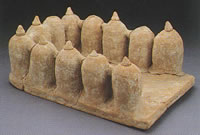 |
|
Model of the granaries to store cereals (2575 B.C.) Tomb from El Kab (Upper Egypt) |
Greek baking taught the Roman people the art of baking, because in Rome they ate the cereal in the form of porridge and pap. Bread was initially eaten by privileged families, but it subsequently became popular food.
The consumption of unleavened bread, without fermenting or yeast, was started by the Hebrew people during the Passover feasts, as they thought that fermented bread contained impurities which had to be avoided.
Before being baked, the wheat grain is ground until it becomes flour. The first mills were basically two small rocks which ground the wheat, powered by animal strength. Subsequently, watermills represented significant progress, which in turn were replaced by windmills. Greece perfected the art of milling and sifting, by separating the remains of the wheat to obtain flours of different shades of white, they reached a high point in the technique of enhancing the flavour of flour.
During the Middle Ages rye bread was made, grass which can be cultivated on poor land, which, although it is nutritional and has a pleasant taste, was not widely accepted. Rye bread is currently being highly valued again.